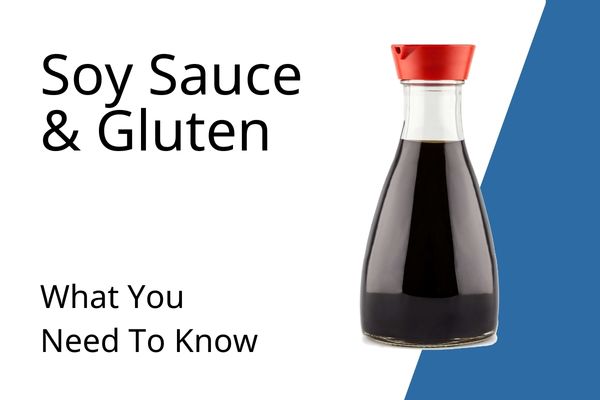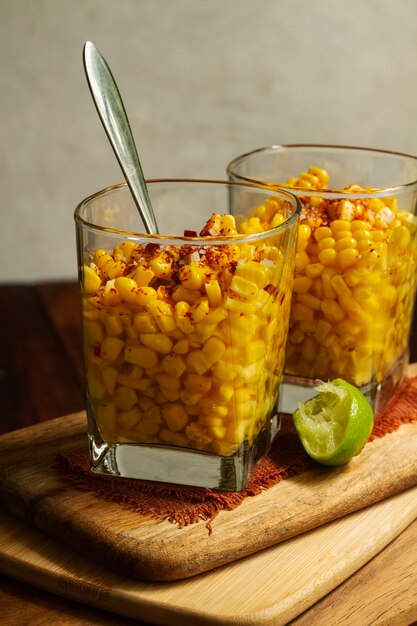Is Soy Sauce Gluten Free – Everything You Need to Know
If you are following a gluten-free diet, it’s important to pay attention to the ingredients in the foods you consume. One common condiment that often raises questions is soy sauce. Many people wonder, “Is soy sauce gluten-free?” The answer is not a simple yes or no, as it depends on the type of soy sauce and how it is made.
Traditional soy sauce is made from fermented soybeans, wheat, water, and salt. This traditional version is not gluten-free, as the wheat in the ingredients contains gluten. However, there are gluten-free alternatives available on the market. These alternatives are made using different ingredients and processes to remove or replace the wheat component.
If you have celiac disease or are highly sensitive to gluten, it’s important to choose gluten-free soy sauce to avoid any potential adverse reactions. Look for soy sauces that are labeled specifically as gluten-free, as they are made without any wheat or gluten-containing ingredients. Some gluten-free soy sauces are made using ingredients like tamari (a type of soy sauce made without wheat) or by using alternative grains like rice or corn.
Even if a soy sauce is labeled as gluten-free, it’s still a good idea to read the ingredients list carefully, as some brands may add additional flavorings or ingredients that could potentially contain gluten. When in doubt, reach out to the manufacturer for more information about their production processes and testing procedures for gluten contamination.
In conclusion, while traditional soy sauce contains gluten, there are gluten-free alternatives available. Always check the label and ingredient list, and if you have any doubts, consult with a healthcare professional or the manufacturer to ensure that you are choosing a soy sauce that is safe for your gluten-free diet.
What is Soy Sauce?
Soy sauce is a savory condiment made from fermented soybeans, roasted grains, water, and salt. It is a staple ingredient in Asian cuisine, particularly in Chinese, Japanese, and Korean dishes. Soy sauce has a distinct umami flavor which adds depth and richness to recipes.
To produce soy sauce, soybeans are first cooked and then mixed with roasted grains such as wheat, barley, or rice. This mixture is then combined with a fermenting agent such as mold or yeast and left to ferment for a period of time, ranging from several months to several years. During fermentation, enzymes break down the proteins and carbohydrates in the soybeans and grains, creating amino acids and enhancing the flavor of the sauce.
Once the fermentation process is complete, the mixture is strained to remove solids, resulting in a liquid that is dark brown in color and has a salty and tangy taste. The sauce is then pasteurized and bottled for distribution.
Soy sauce is commonly used as a seasoning or marinade for various dishes, including stir-fries, sushi, noodles, and dipping sauces. It can also be used as a condiment to add flavor to rice, vegetables, and meats. There are different types of soy sauce available, including light soy sauce, dark soy sauce, and tamari (gluten-free soy sauce).
Overall, soy sauce is a versatile and flavorful ingredient that adds a unique taste to a wide range of dishes. However, it’s important to note that not all soy sauces are gluten-free, as some may contain wheat or other gluten-containing grains. If you follow a gluten-free diet, it’s essential to check the label or choose a certified gluten-free soy sauce to ensure it is safe for consumption.
What is Gluten?
Gluten is a protein found in wheat, barley, rye, and other related grains. It is responsible for giving dough its elasticity and helps it rise during baking. Gluten can be found in various food products such as bread, pasta, baked goods, and even certain sauces and condiments.
For individuals with celiac disease or gluten sensitivity, consuming gluten can lead to digestive issues, damage to the small intestine, and other symptoms. Therefore, it is important for those individuals to follow a gluten-free diet.
Gluten-free products are made with alternative flours or grains that do not contain gluten, such as corn, rice, or quinoa. These products are safe for individuals with gluten intolerance or celiac disease to consume.
When determining if a product is gluten-free, it is important to carefully read the ingredients list or look for gluten-free certification labels. Some products, like soy sauce, can contain gluten as it is traditionally made with wheat. However, there are gluten-free versions of soy sauce available on the market for individuals with gluten restrictions.
If you have celiac disease or gluten sensitivity, it is best to consult with a healthcare professional or registered dietitian to ensure you are following a strict gluten-free diet and making safe food choices.
Is Soy Sauce Gluten Free?
Soy sauce is a common condiment that is used in many Asian cuisines, but it is important to know whether it is gluten-free or not, especially for people with gluten intolerance or celiac disease.
Traditional soy sauce is made from fermented soybeans, water, salt, and often roasted grains. The traditionally brewed soy sauce, such as Japanese shoyu or tamari, typically contains wheat as one of the main ingredients, making it not gluten-free.
However, there are now gluten-free soy sauces available in the market. These gluten-free soy sauces are made with alternative grains, such as rice or corn, instead of wheat. They are specifically made to cater to people who follow a gluten-free diet.
When looking for gluten-free soy sauce, it is important to read the label carefully and look for the gluten-free certification logo. This ensures that the soy sauce has been tested and meets the strict standards for gluten-free products.
It is also worth noting that there are soy sauce alternatives that are naturally gluten-free, such as coconut aminos or tamari sauce, which is made from soybeans but without the addition of wheat.
Overall, if you have a gluten intolerance or celiac disease, it is important to choose gluten-free soy sauce to avoid any adverse reactions. There are plenty of gluten-free options available, so you can still enjoy the rich umami flavor that soy sauce adds to your dishes.
Gluten-Free Alternatives to Soy Sauce
While soy sauce is a common ingredient in many Asian dishes, individuals with gluten sensitivity or celiac disease need to look for gluten-free alternatives. Fortunately, there are several options available that can replace soy sauce and still provide the savory umami flavor we love.
1. Tamari: Tamari is a type of soy sauce that is traditionally made without wheat. It is made from fermented soybeans and has a rich, dark flavor. Tamari is a great gluten-free alternative to regular soy sauce and can be used in marinades, stir-fries, and dressings.
2. Coconut Aminos: Coconut aminos are made from the sap of coconut blossoms and are a popular gluten-free and soy-free alternative to soy sauce. They have a slightly sweet and savory flavor and can be used in a variety of dishes.
3. Liquid Aminos: Liquid aminos are a gluten-free and low-sodium alternative to soy sauce. They are made from soybeans and have a similar flavor profile to soy sauce. Liquid aminos can be used as a marinade or as a seasoning for your favorite dishes.
4. Tamari and Coconut Aminos Blend: Some brands offer a blend of tamari and coconut aminos, providing a unique flavor combination that is gluten-free and soy-free. This blend is great for those who are looking for a sweeter and milder alternative to soy sauce.
5. Homemade Soy Sauce Substitutes: If you prefer to make your own soy sauce substitute, there are recipes available online that use ingredients like beef stock, balsamic vinegar, and molasses to create a gluten-free alternative with a similar flavor profile.
Remember to always check the label of the alternative sauce you choose, as some brands may contain hidden sources of gluten. With these gluten-free alternatives, you can still enjoy the flavors of your favorite dishes without sacrificing taste or your dietary needs.
Tips for Finding Gluten-Free Soy Sauce
When shopping for soy sauce, it’s important to carefully read the labels to ensure that it is gluten-free. Here are some tips to help you find gluten-free soy sauce:
1. Look for a Gluten-Free Label
One of the easiest ways to find gluten-free soy sauce is to look for products that are labeled as such. Many brands now provide gluten-free options, so keep an eye out for labels that say “gluten-free” or “certified gluten-free”. These products have been tested and meet the gluten-free standards.
2. Check the Ingredients List
Even if a soy sauce brand doesn’t have a gluten-free label, you can still determine if it is gluten-free by checking the ingredients list. Look for soy sauce made from gluten-free ingredients like soybeans, water, and salt. Avoid products that contain wheat or any other gluten-containing grain.
Also, keep in mind that some soy sauce brands may use fermented wheat as a flavor enhancer, even if it’s not listed as a main ingredient. In such cases, it’s best to choose a different brand or opt for gluten-free alternatives.
3. Explore Gluten-Free Alternatives
If you are unable to find a gluten-free soy sauce that meets your dietary needs, consider exploring gluten-free alternatives. There are several gluten-free soy sauce alternatives available that are made from ingredients like tamari, coconut aminos, or liquid aminos. These products can provide a similar flavor profile without the gluten.
| Alternative | Description |
|---|---|
| Tamari | Tamari is a Japanese soy sauce made without wheat. It has a rich, savory flavor and is a popular gluten-free soy sauce alternative. |
| Coconut Aminos | Coconut aminos is a sauce made from the fermented sap of coconut palm and sea salt. It has a slightly sweet and salty taste, similar to soy sauce. |
| Liquid Aminos | Liquid aminos are a gluten-free alternative to soy sauce made from non-GMO soybeans. It is often used in vegan and vegetarian cooking. |
By following these tips, you can ensure that you find a gluten-free soy sauce that fits your dietary needs and enjoy your meals without any gluten-related concerns.
“FAQ:” Is soy sauce gluten free
What is the difference between Kikkoman soy sauce and gluten-free tamari?
Kikkoman soy sauce is traditionally brewed with wheat, while gluten-free tamari is a soy sauce alternative that doesn’t contain wheat.
How much gluten is typically found in soy sauce that’s not labeled gluten-free?
Soy sauce that is not labeled gluten-free can contain significant amounts of gluten due to the fermentation process involving wheat.
Can people with celiac disease consume soy sauce?
People with celiac disease should avoid regular soy sauce as it contains gluten. They can opt for gluten-free tamari soy sauce as a safe alternative.
Is San-J Tamari soy sauce a gluten-free option?
Yes, San-J Tamari soy sauce is gluten-free, making it a suitable choice for those who need to stick to a gluten-free diet.
Why should individuals looking to avoid gluten choose a gluten-free soy sauce?
Choosing a gluten-free soy sauce ensures that individuals can enjoy the flavor of soy sauce without consuming gluten, which is essential for those with gluten sensitivity or celiac disease.
Can you use soy sauce as a great substitute for Worcestershire sauce?
While soy sauce and Worcestershire sauce have distinct flavors, soy sauce can be a good substitute, especially when seeking a gluten-free option.
Why is rice often used instead of wheat in premium soy sauces?
Premium soy sauces may use rice instead of wheat to cater to individuals looking for gluten-free options and to enhance the sauce’s overall quality.
How is soy sauce originally brewed, and why was it traditionally made with wheat?
Soy sauce is traditionally brewed with fermented soybeans, wheat, and salt. Wheat was included in the process to enhance the flavor and fermentation.
What is the gluten content in traditional Kikkoman soy sauce?
Traditional Kikkoman soy sauce contains gluten due to the use of wheat in the fermentation process.
Are there soy protein and fermented soy in a typical soy sauce option?
Yes, soy sauce often contains soy protein and is made through the fermentation of soybeans.
What should you consider when you’re looking for another gluten-free soy sauce?
When looking for another gluten-free soy sauce, it’s important to check if it’s marked as gluten-free and review the ingredients label.
Why was soy sauce originally brewed, and is it considered a staple in many cuisines?
Soy sauce was originally brewed for its rich umami flavor, and it has become a staple in many cuisines around the world.
Can individuals with gluten sensitivity eat popular soy sauce brands like Kikkoman?
Individuals with gluten sensitivity should avoid soy sauce that is not labeled gluten-free, including popular brands like Kikkoman, and opt for alternatives marked gluten-free.




